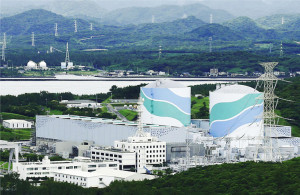
This step can be considered a milestone for Japan due to a number of reasons that go far beyond purely economic factors. It is safe to say that it’s the economy that had to suffer the most when the Japanese government on March 2014 began shutting down all 48 nuclear reactors across Japan in order to “double-check” the safety systems. The possibility of recovering the six reactors of Fukushima Daiichi is out of the question.
The problem is that the usage of traditional electropower stations (to compensate for the decreasing output caused by the closure of Japanese nuclear power plants) led to a sharp increase of imports of hydrocarbons. This was the main factor behind Japan’s negative trade balance that, for the first time in the last three decades, surfaced back in 2011. And over the subsequent years it has been increasing continuously.
Despite the positive effect of the measures taken by Prime Minister Shinzo Abe that allowed the government to increase exports, imports had been effectively outpacing them. By the end of 2013, the Japanese foreign trade negative balance amounted to 15 billion dollars.
It is important to note that, despite the trend towards an increasing reliance on military power in its foreign policy, Japan has always relied on its economic power in achieving its goals upon the world stage.
While competition with China has been the primary issue of Japan’s foreign policy, maintaining economic “health” of its country is imperative for the Japanese. Therefore, Japan must adopt a new energy strategy that has been repeatedly delayed over the years. Previous strategy that had been adopted back in 2010 was aimed at accelerating the construction of nuclear power plants and bringing the share of nuclear power in the country’s energy balance to 50% in 2030.
The Japanese economy that stagnated in the early 90s was able to push through due to the increase in production of cheap electricity. In addition, the accelerated “nuclearization” of Japan should have allowed the country to supply up to 70% of it energy demand in 2030 (from the current 10-20%), along with reducing the amount of greenhouse emissions. These have been buried by the nuclear disaster at the Fukushima Daiichi plant.
The discussion about the future of Japan’s energy highlighted two lobby groups. The first one is associated with the current government and industry and it is fighting for cheap electricity. The second represents the mood of the majority of Japan’s inhabitants, and it wants “safe and clean” energy.
The non-official leader of the broad movement for abandoning nuclear power is one the most influential politicians of today’s Japan – former Prime Minister Junichiro Koizum, who‘s term lasted from 2001 to 2006. The drama of the situation lies in the fact that he is considered to be the “godfather” of the sitting Prime Minister Shinzo Abe, the latter seems to be pro-nuclear. Shinzo Abe‘s position is justified by the need to support the struggle of the leading Japanese industrial companies that are desperate to obtain orders on the construction of nuclear power plants abroad.
For instance, the Mitsubishi Heavy Industries deal on the construction of nuclear plants in Tukrey (worth 22 billion dollars) has almost been derailed by Japan’s internal struggle. Turks have reasonably pointed out to their Japanese counterparts that they will not be buying technology that scares its own creators.
While the Nuclear Regulation Authority fights to bring nuclear plants back online, a keen reader must remember who in March 2011 was the first initiator of the campaign against nuclear energy. It was not the then Japanese Prime Minister Yoshihiko Noda.
The latter has simply followed the example of German Chancellor Angela Merkel, who after the Fukushima disaster announced her intention to completely abandon nuclear power in ten years. All that Merkel could possibly do is resort to rhetoric about renewable energy as well. But one shouldn’t downplay the importance of political wrestling in Germany in the run-up to a number of election campaigns. Merkel had to effectively “disarm” the Greens that were gaining popularity at the time.
Since then the world has been waiting in anticipation for another German miracle. However, experts are becoming less and less optimistic with each passing day. German‘s abandonment of nuclear energy has been transformed into a grotesque show. The fact is that while Merkel’s plan is being implemented, Germany is transforming from an exporter of electricity into an importer. And the primary supplier of electricity to Germany today is France. French nuclear plants are producing 80% of all electricity in France, and geographically speaking – it’s not that far from Germany for Germans to feel reassured.
In engineering it is crucial that all projects must be carefully planned and implemented. Otherwise – trouble is inevitable, no mater what laws of physics are behind them. One couldn’t possibly imagine what might happen to a large city if a hydroelectric station upstream of it was left unattended. Nuclear power has brought nothing fundamentally new to the threats of human existence.
Vladimir Terekhov, leading research fellow at the Centre for Asian and Middle Eastern Studies at the Russian Institute of Strategic Research, exclusively for the online magazine “New Eastern Outlook”.
